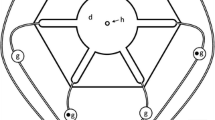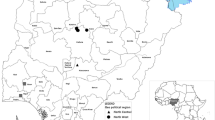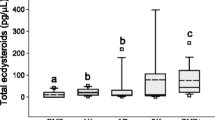Summary
Behavioral responses of differently aged worker beesApis mellifera to a queen pheromonal extract were analysed. The bees were tested individually in a four-armed olfactometer, one arm being scented with the pheromonal extract. This extract was prepared from heads of 14–17-day-old unmated queens. Among the components of the blend, 470 μg 9-keto-2-(E)-decenoic acid, 200 μg 9-hydroxy-2-(E)-decenoic acid and 5 μgp-hydroxybenzoic acid methyl ester per queen equivalent were dosed. An age dependency in the worker bees' olfactory response to the components of the queen extract was shown, the strongest response occurring below the age of 5 days.
Similar content being viewed by others
References
Allan, S. A., K. N. Slessor, M. L. Winston and G. G. S. King, 1987. The influence of age and task specialization on the production and perception of honey bee pheromones.J. Insect Physiol. 33:917–922.
Allen, M. D., 1955. Observations on honeybees attending their queen.Brit. J. Anim. Behav. 3:66–69.
Allen, M. D., 1960. The honeybee queen and her attendants.Anim. Behav. 8:201–208.
Boch, R., D. A. Shearer and J. C. Young, 1975. Honey bee pheromones: field tests of natural and artificial queen substance.J. Chem. Ecol. 1:133–148.
Butler, C. G., 1954. The method and importance of the recognition by a colony of honeybees (A. melliferd) of the presence of its queen.Trans. R. Eut. Soc. Lond. 105:11–29.
Butler, C. G. and J. Simpson, 1958. The source of queen substance of the honeybee (Apis mellifera L.).Proc. R. Ent. Soc. Land. A, 33:120–122.
Crewe, R. M., 1982. Compositional variability: the key to the social signals produced by honeybee mandibular glands. In:The Biology of Social Insects, (M. D. Breed, C. D. Michener and H. E. Evans, Eds.), pp. 318–322, Westview Press, Boulder Colorado.
De Groot, A. P. and S. Voogd, 1954. On the ovary development in queenless worker bees (Apis mellifica).Experientia 10:384–385.
De Hazan, M., Y. Lensky and P. Cassier, 1989. Effects of queen honeybee (Apis mellifera L.) ageing on her attractiveness to workers.Comp. Biochem. Physiol. 93:777–783.
Ferguson, A. W. and J. B. Free, 1980. Queen pheromone transfer within honeybee colonies.Physiol. Entomol. 5:359–366.
Gascuel, J. and C. Massen, 1987. Influence of olfactory deprivation on synapse frequency in developing antenal lobe of the honeybeeApis mellifera.Neuroscience Research Communications 1:173–180.
Gary, N. E., 1961. Queen honeybee attractiveness as related to mandibular gland secretion.Science 133:1479–1480.
Kaminski, L. -A., K. N. Slessor, M. L. Winston, N. W. Hay and J. H. Borden, 1990. Honeybee response to queen mandibular pheromone in laboratory bioassays.J. Chem. Ecol. 16:841–850.
Lindauer, M., 1952. Ein Beitrag zur Frage der Arbeitsteilung im Bienenstaat.Z. Vergl. Physiol. 34:299–345.
Massen, C. and G. Arnold, 1984. Ontogeny, maturation and plasticity of the olfactory system in the worker bee.J. Insect Physiol. 30:7–14.
Pain, J., 1954. Sur l'ectohormone des reines d'Abeilles.C. R. Acad. Sci. 239:1869–1870.
Pain, J., 1961. Sur la phérormone des reines d'Abeilles et ses effects physiologiques.Ann. Abeille 4:73–152.
Pain, J., 1966. Nouveau modèle de cagettes expérimentales pour le maintien d'abeilles en captivité.Ann. Abeille 9:71–76.
Pain, J., M. Barbier, D. Bogdanovsky and E. Lederer, 1962. Chemistry and biological activity of the secretions of queens and worker honeybees (Apis mellifica L.).Comp. Biochem. Physiol. 6:233–241.
Pain, J., M. Barbier and B. Roger, 1967. Dosges individuels des acides céto-9 décene-2 oïque et hydroxy-10 décène-2 oïque dans les têtes des reines et des ouvrières d'abeilles.Ann. Abeille 10:45–52.
Pain, J., B. Roger and J. Theurkauff, 1974. Mise en évidence d'un cycle saisonnier de la teneur en acides céto-9 et hydroxy-10 décène-2 oïque des têtes de reines vierges d'abeilles.Apidologie 5:319–355.
Pain, J. and B. Roger, 1978. Rythmes circadiens des acides céto-9 et hydroxy-10 décène-2 oïque des ouvrières d'abeillesApis mellifica ligustica S.Apidologie 9:263–272.
Perepelova, L. I., 1928. The nurse bees.Opuit. Pas. 12:551–557.
Pham, M. -H., B. Roger and J. Pain, 1982. Variation en fonction de l'âge des ouvrières d'abeilles (Apis mellifica ligustica S.) du pouvoir d'attraction d'un extrait de pheromones royales.Apidologie 13:143–155.
Pham-Delegue, M. -H., B. Roger, R. Charles and C. Masson, 1990a. Effet d'une pré-exposition olfactive sur un comportement d'orientation en olfactomètre dynamique à quatre voies chez l'abeille (Apis mellifica L.).Ins. Soc. 37:181–187.
Pham-Delegue, M. -H., M. Le Metayer, P. Douault and C. Masson, 1990b. Age-related foraging behaviour in honey bees under artificial conditions.Apidologie 21:107–114.
Rösch, G. A., 1925. Untersuchungen über die Arbeitsteilung im Bienenstaat. Z.Vergl. Physiol. 6:571–631.
Sakagami, S. F., 1953. Untersuchungen über die Arbeitsteilung in einem Zwergvolk der Honigbiene. Beitrag zur Biologie des Bienenvolkes,Apis mellifica L.Jpn J. Zool. 11:117–185.
Seeley, T. D., 1982. Adaptative significance of the age polyethism schedule in honeybees colonies.Behav. Ecol. Sociobiol. 11:287–293.
Simpson, J., 1979. The existence of physical properties of pheromones by which worker bees recognize queens.J. Apic. Res. 18:233–249.
Slessor, K. N., L. -A. Kaminski, G. G. S. King, J. H. Borden and M. L. Winston, 1988. Semiochemical basis of the retinue response to queen honey bees.Nature 332:354–356.
Slessor, K. N., L. -A. Kaminski, G. G. S. King and M. L. Winston, 1990. Semiochemicals of the honeybee queen mandibular glands.J. Chem. Ecol. 16:851–860.
Velthuis, H. H. W., 1982. Communication and the swarming process in honeybees. In:The Biology of Social Insects, (M. D. Breed, C. D. Michener and H. D. Evans, Eds.) Proc. 9th IUSSI Cong., Westview Press, Boulder Colorado, pp. 323–328.
Velthuis, H. H. W., 1985. The honeybee queen and the social organization of her colony.Fortschr. Zool. 31:342–357.
Vet, L. E. M., J. C. Van Lenteren, N. Heymans and E. Meelis, 1983. An airflow olfactometer for measuring olfactory responses of hypemopterous parasitoids and other small insects.Physiol. Entomol. 8:97–106.
Author information
Authors and Affiliations
Rights and permissions
About this article
Cite this article
Pham-Delegue, M.H., Trouiller, J., Bakchine, E. et al. Age dependency of worker bee response to queen pheromone in a four-armed olfactometer. Ins. Soc 38, 283–292 (1991). https://doi.org/10.1007/BF01314914
Received:
Revised:
Accepted:
Issue Date:
DOI: https://doi.org/10.1007/BF01314914




